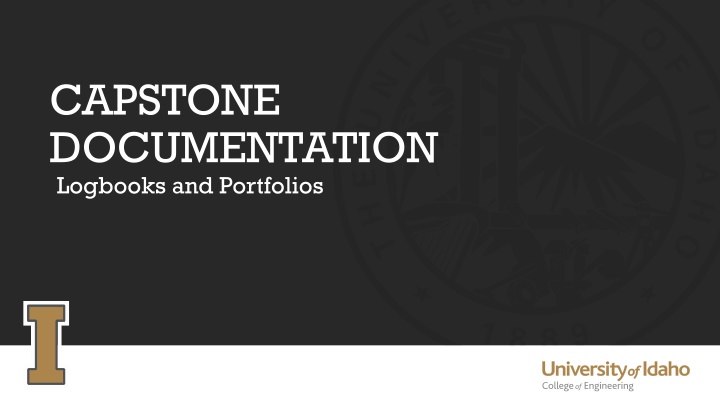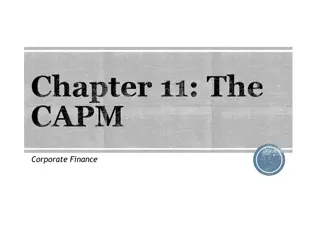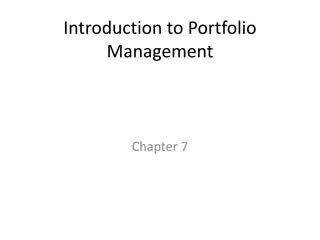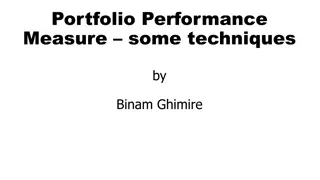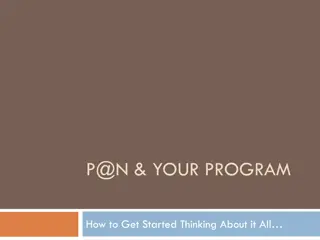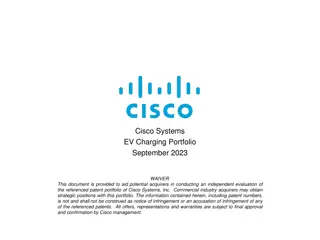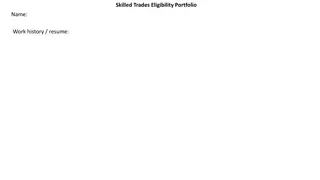Capstone Documentation and Portfolio Management
In this capstone project, students are required to maintain logbooks, e-portfolios, and self-assessment forms to track their progress and reflect on their performance. The project encompasses various elements including grading matrices, logbook entries, assessment of strengths and areas for improvement, as well as building a comprehensive e-portfolio containing essential design documents. Students are guided to evaluate their work and aim for exemplary ratings to achieve high grades in the capstone course.
Download Presentation

Please find below an Image/Link to download the presentation.
The content on the website is provided AS IS for your information and personal use only. It may not be sold, licensed, or shared on other websites without obtaining consent from the author.If you encounter any issues during the download, it is possible that the publisher has removed the file from their server.
You are allowed to download the files provided on this website for personal or commercial use, subject to the condition that they are used lawfully. All files are the property of their respective owners.
The content on the website is provided AS IS for your information and personal use only. It may not be sold, licensed, or shared on other websites without obtaining consent from the author.
E N D
Presentation Transcript
CAPSTONE DOCUMENTATION Logbooks and Portfolios
GRADING MATRIX ONE DRIVE e-portfolio
LOGBOOK SELF-ASSESSMENT FORM 1. Identify your top five entries (since last collection) 2. Rate your performance in four areas using a 1-5 scale: - Project Management - Design Development - Assessment/Reflection - Organization 3. Make an entry on logbook strengths & areas for improvement
LOGBOOK RATING SCALE 1 Missing 2 Incomplete, minimal long-term value to author 3 moderate, some long-term value to author 4 Complete, clear long-term value to author 5 Exemplary, considerable long-term value to others An average rating of 4.25 is the threshold for an A logbook An average rating of 3.50 is the threshold for a B logbook An average rating of 2.75 is the threshold for a C logbook Your Logbook Grade will be based on your final submission => Use initial instructor review to calibrate
IDEAS FOR INITIAL LOGBOOK ENTRIES What was the greatest value added by the projects fair beyond the online descriptions? Did you experience anything unexpected? Was there a benefit to listening to the questions/answers of others? What did you learn about yourself from this process? How did the experience prepare you for capstone design?
E-PORTFOLIOS A team portfolio is a living record of the team's progress. A well-built portfolio will save time in creating reports and presentations A high-quality portfolio is useful for the client and future design teams in addition to the current design team. It contains essential design documents necessary to replicate your work
E-PORTFOLIO CONTENTS 1 Problem Definition 2 Project Learning 3- Project Management * Meeting Minutes * Budgeting (including purchasing paperwork) 4 Design Solution 5 Implementation/Manufacturing 6 Design Validation 7 Final Project Documentation
Meeting Minutes Meeting Minutes Weekly action items Summary of progress Meeting review: Helpful/Not Attendance and participation Team member contributions
Balance Sheet/Budget Budget Initial Budget Estimated cost for Materials/components/labor Spending plan
Design Goals Client need and project goal (with timeline). Design Goals Revision of goal. Why the revision was necessary? New goal
Specifications and constraints Documentation of client interview notes, pictures, measurements, etc. Design Specs. Design specifications and constraints. Make notes on the reason(s) behind any constraints given by client.
Project Learning Learning Project What off-the-shelf technologies you can use to solve the problem? Why did you think the design would work? Why the design did not work. What needed to be changed?
System Diagrams Use standard symbols. Properly label and reference. May use software (such as Visio, lucid chart, AutoCAD SolidWorks ) or freehand. Diagrams , System Document who drew and what software was used.
Analysis of Alternatives Discussion on possible alternatives and why some alternatives are better than other. Safety Alternative Analysis Less moving parts Lower cost Durability Compatibility Foolproof
Engineering Modeling Physical/Chemical/Biological/C omputer system modeling. Modeling criteria, expected accuracy, pitfalls. Which modeling software was used? Modeling What data was needed, how the data was obtained. Validation scheme for the model.
Manufacturing/ Implementation Plan Fabrication need. Flowchart for process oriented projects. Bill of materials, drawings. Manufacturer/supplier and delivery time. Mfg. Plan
Experimental Design Characterize the purpose of the experiment. Model validation? Data gap? Performance measurement? Detailed documentation on instrumentation and measurements. Design Exp.
Analysis Data Analysis Data Document statistical tools used. Document accuracy of data, and experiment. Write about the confidence in your results. What conclusions can be made?
